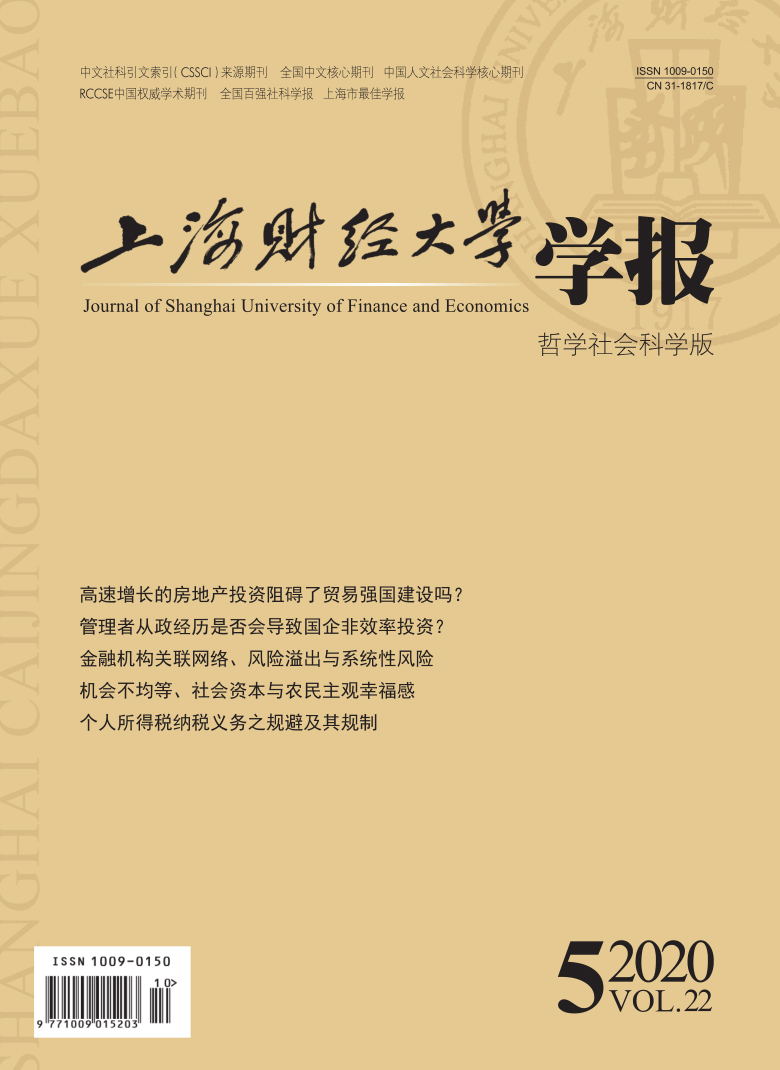文章以中国高端制造业出口和房地产投资匹配后的地区数据为样本,从供给端系统研究了高速增长的房地产投资对贸易强国建设的影响,并重点考察了其中的异质性特征与机制路径。结果表明,高速增长的房地产投资阻碍了贸易强国建设:房地产投资增速上升1%,制造业出口技术复杂度下降0.068%,数量规模下降0.019%。该阻碍作用在东部发达地区主要体现在出口技术复杂度上,而在中西部欠发达地区则表现在数量规模上。中介效应分析表明,技术溢出收窄和成本收益率降低是房地产投资阻碍贸易强国建设的重要路径。当然,文章通过内生性处理和稳健性检验严格保证了上述结论的科学有效性。据此,文章结合当前疫情冲击、中美摩擦等现实挑战,分别从继续优化房地产市场平稳健康发展的长效机制、支持实体部门纾困、落实贸易强国愿景和推动国内国际双循环等方面给出建议。
高速增长的房地产投资阻碍了贸易强国建设吗?——来自中国高端制造业出口数据的经验判断
摘要
参考文献
13 李江涛,褚磊,纪建悦. 房地产投资与工业全要素生产率[J]. 山东大学学报(哲学社会科学版),2018,(5). DOI:10.3969/j.issn.1001-9839.2018.05.012
17 毛其淋,方森辉. 创新驱动与中国制造业企业出口技术复杂度[J]. 世界经济与政治论坛,2018,(2). DOI:10.3969/j.issn.1007-1369.2018.02.003
34 张晓磊,徐林萍. 房价上涨与中小微企业融资成本——基于江苏省中小微企业调研数据的实证[J]. 中国软科学,2020,(4). DOI:10.3969/j.issn.1002-9753.2020.04.001
38 Arellano M,Bover O. Another look at the instrumental variable estimation of error-components models[J]. Journal of Econometrics,1995,68:29–51. DOI:10.1016/0304-4076(94)01642-D
39 Blundell R,Bond S. Initial conditions and moment restrictions in dynamic panel data models[J]. Journal of Econometrics,1998,87(1):115–143. DOI:10.1016/S0304-4076(98)00009-8
40 Baron,R M,Kenny,D A. The moderator-mediator variable distinction in social psychological research:Conceptual,strategic,and statistical considerations[J]. Journal of Personality and Social Psychology,1986,51:1173–1182. DOI:10.1037/0022-3514.51.6.1173
41 Chaney T,Sraer D,Thesmar D. The collateral channel:How real estate shocks affect corporate investment[J]. American Economic Review,2012,102(6):2381–2409. DOI:10.1257/aer.102.6.2381
42 Charles K K,Hurst E,Notowidigdo M J. Housing booms and busts,labor market opportunities,and college attendance[J]. American Economic Review,2018,108(10):2947–2994. DOI:10.1257/aer.20151604
43 Chen A H,Ling D C. Optimal mortgage refinancing with stochastic interest rates[J]. Real Estate Economics,1989,17(3):278–299. DOI:10.1111/1540-6229.00492
44 Chen N K,Leung C K Y. Asset price spillover,collateral and crises:With an application to property market policy[J]. The Journal of Real Estate Finance and Economics,2008,37(4):351–385. DOI:10.1007/s11146-007-9095-x
45 Engelhardt G. House prices and home owner saving behavior[J]. Regional Science and Urban Economics,1996,26(3–4):313–336. DOI:10.1016/0166-0462(95)02118-3
46 Gan J. Collateral,debt capacity,and corporate investment:Evidence from a natural experiment[J]. Journal of Financial Economics,2007,85(3):709–734. DOI:10.1016/j.jfineco.2006.06.007
47 Gereffi G. International trade and industrial upgrading in the apparel commodity chain[J]. Journal of International Economics,1999,48(1):37–70. DOI:10.1016/S0022-1996(98)00075-0
48 Hausmann R,Hwang J,Rodrik D. What you export matters[J]. Journal of Economic Growth,2007,12(1):1–25. DOI:10.1007/s10887-006-9009-4
49 Hayes A F. Beyond baron and Kenny:Statistical mediation analysis in the new millennium[J]. Communication Monographs,2009,76(4):408–420. DOI:10.1080/03637750903310360
50 Hurst E,Stafford F. Home is where the equity is:Mortgage refinancing and household consumption[J]. Journal of Money,Credit and Banking,2004,36(6):985–1014. DOI:10.1353/mcb.2005.0009
51 Melitz M J. The impact of trade on intra-industry reallocations and aggregate industry productivity[J]. Econometrica,2003,71(6):1695–1725. DOI:10.1111/1468-0262.00467
52 Mian A,Sufi A. What explains the 2007−2009 drop in employment[J]. Econometrica,2014,82(6):2197–2223. DOI:10.3982/ECTA10451
引用本文
王诗勇, 董敏凯, 王洪卫. 高速增长的房地产投资阻碍了贸易强国建设吗?——来自中国高端制造业出口数据的经验判断[J]. 上海财经大学学报, 2020, 22(5): 3-17.
导出参考文献,格式为:





 4079
4079  6389
6389

